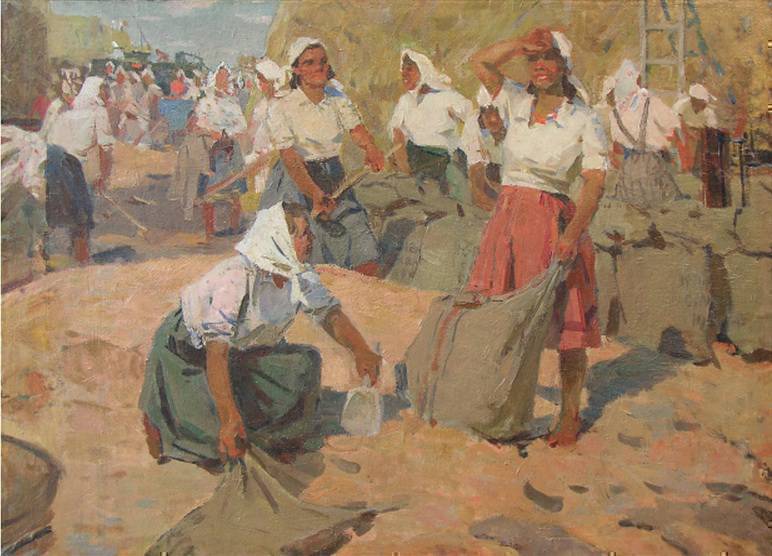Grain Harvest

Yablonskaya, Tatiana Nilovna
1917 - 2005
Grain Harvest
Oil on Canvas
77 x 105cm
1946
PROVENANCE:
T. Yablonskaya's studio
Given by the artist to her pupil Oleksa Zahorchuk
Ukrainian Private Collection
The present painting by Tatiana Yablonskaya is an important live study for the artist’s major masterpiece Grain Harvest (1949, оil on canvas, 201 x 317 cm, the State Tretiakov Gallery). Grain Harvest was a turning point in Yablonskaya’s career. It brought her a Stalin award in 1950 and bronze medal at Brussels World Art Fair in 1958. Depicting a joyful harvesting scene, the picture became an icon in Soviet imagery.
This study was executed in 1946 when Yablonskaya lead a student group on an internship in the Lenin kolkhoz, a collective farm in the Letava village in Khmelnitsky region. In her memoirs “How I worked on Grain Harvest”, the artist describes this painting as one of “five oil canvases painted at different times of day, about a meter on the long side”. As in the famous final version, the scene takes place under glaring midday sun. Earthy ochre and pale pink dominate the palette, with some added splashes of greens and blues. The fresh, white colors of women blouses and scarves accentuate the harmonious rhythm and festive atmosphere of work in a kolkhoz.
The canvas shows a group of young women with shovels and scoops gathering grain in sacks on the threshing floor. One of the sacks on the right, similar to the final canvas, bears the year and letters “K-p i…/s. LE../19..” that stand for “Lenin collective farm in Letava”. The women are wearing short pleated skirts and white blouses. Their heads are covered with headscarves. The skirts are shorter and narrower in this preparatory work as compared to full and long traditional Ukranian attire from the later canvas.
We are grateful to the artist’s daughter Gayane Atayan for providing an illuminatingpassage from the artist’s private archive: “[In Letava] they wear ‘city’-fashion narrow skirts that are in my opinion uncomfortable and ugly. I dressed my heroines in typical Ukranian [ones] . . . I was told that the Letava’s kolkhoz farmers were disappointed that I portrayed them as ‘old fashioned’”.
The canvas focuses on two central figures – one is kneeling with a scoop and the other paused to catch a breath is holding a large sack with one hand, while raising the other to shield her eyes from bright sunlight. This raised-hand gesture, Yablonskaya’s sharp observation, appears also on a pencil drawing from the artist’s archive (below, courtesy of Gayane Atayan).
All other figures аre captured in mid-movement around the resting woman, as if in a complexly choreographed dance. Many sacks are already full of grain, indicating that the working day started early, perhaps before sunrise. Huge haystacks occupy the background, parting slightly to reveal blue sky in the left corner.
Later Yablonskaya reworked the Harvest composition to make it more panoramic and grand. This canvas, however, bears the freshness and immediacy of the actual day of late summer of 1946. Here Yablonskaya masterfully captures the busy and cheerful atmosphere of the harvest. The confident execution of the study makes it a prime showcase of Yablonskaya’s artistic talent and ability to create a finished canvas on the spot. Highlighting the historical and artistic importance of this work, the leading Ukranian art historian and expert Vladimir Tzitovich calls this work “an insight in the artist’s laborious input into creation of the masterpiece”.
The canvas remained in Yablonskaya’s studio for several years until she gave it to one of her favorite pupils, Oleksa Zaharchuk, whom she met in 1952.


